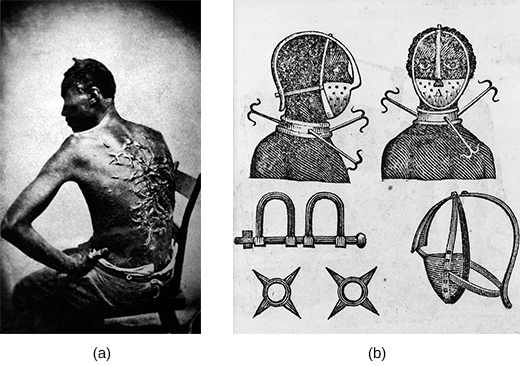| << Chapter < Page | Chapter >> Page > |
In addition to cotton, the great commodity of the antebellum South was human chattel. Slavery was the cornerstone of the southern economy. By 1850, about 3.2 million slaves labored in the United States, 1.8 million of whom worked in the cotton fields. Slaves faced arbitrary power abuses from whites; they coped by creating family and community networks. Storytelling, song, and Christianity also provided solace and allowed slaves to develop their own interpretations of their condition.
Southern whites frequently relied upon the idea of paternalism —the premise that white slaveholders acted in the best interests of slaves, taking responsibility for their care, feeding, discipline, and even their Christian morality—to justify the existence of slavery. This grossly misrepresented the reality of slavery, which was, by any measure, a dehumanizing, traumatizing, and horrifying human disaster and crime against humanity. Nevertheless, slaves were hardly passive victims of their conditions; they sought and found myriad ways to resist their shackles and develop their own communities and cultures.
Slaves often used the notion of paternalism to their advantage, finding opportunities within this system to engage in acts of resistance and win a degree of freedom and autonomy. For example, some slaves played into their masters’ racism by hiding their intelligence and feigning childishness and ignorance. The slaves could then slow down the workday and sabotage the system in small ways by “accidentally” breaking tools, for example; the master, seeing his slaves as unsophisticated and childlike, would believe these incidents were accidents rather than rebellions. Some slaves engaged in more dramatic forms of resistance, such as poisoning their masters slowly. Other slaves reported rebellious slaves to their masters, hoping to gain preferential treatment. Slaves who informed their masters about planned slave rebellions could often expect the slaveholder’s gratitude and, perhaps, more lenient treatment. Such expectations were always tempered by the individual personality and caprice of the master.
Slaveholders used both psychological coercion and physical violence to prevent slaves from disobeying their wishes. Often, the most efficient way to discipline slaves was to threaten to sell them. The lash, while the most common form of punishment, was effective but not efficient; whippings sometimes left slaves incapacitated or even dead. Slave masters also used punishment gear like neck braces, balls and chains, leg irons, and paddles with holes to produce blood blisters. Slaves lived in constant terror of both physical violence and separation from family and friends ( [link] ).


Notification Switch
Would you like to follow the 'U.s. history' conversation and receive update notifications?